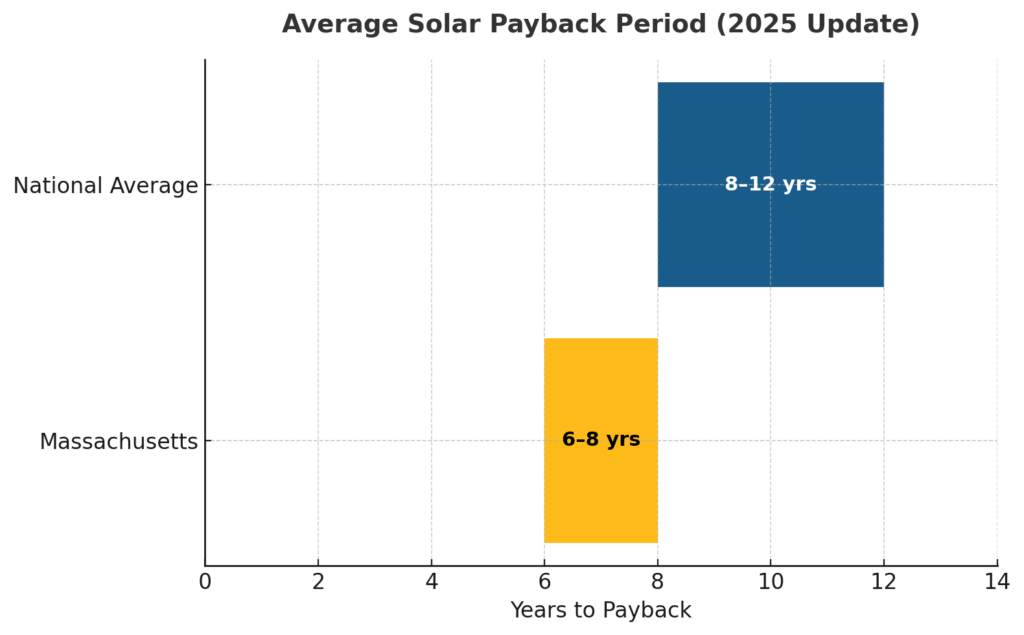Solar Panel Payback Period in Massachusetts (2025 ROI Guide)
Electric bills in Massachusetts aren’t just high — they keep climbing year after year. That’s why more homeowners are asking the same question: “How long does it take for solar panels to pay for themselves?”
The good news? The solar payback period in Massachusetts is among the best in the country. While the national average is 8–12 years, here in the Bay State, most homeowners break even in just 6–8 years. That means you start seeing pure savings faster — and for the remaining 15+ years of your system’s life, your power bills can be dramatically lower, sometimes close to zero.
Put simply: when it comes to solar ROI in Massachusetts, the numbers speak for themselves. Strong state incentives combined with the federal tax credit make it possible to recover your investment quickly and then enjoy decades of financial freedom from utility rate hikes.
What Is the Payback Period for Solar Panels?
Before we dive into the numbers for Massachusetts, let’s clear up what the solar panel payback period actually means. Simply put, it’s the amount of time it takes for your solar system to pay for itself through electricity savings.
The formula is straightforward:
Payback Period = Net System Cost ÷ Annual Energy Savings
For example, if your solar system costs $12,000 after incentives and saves you about $1,800 a year on your electricity bill, your solar break-even point would be around 6.6 years. After that, every year of production is pure savings.
Nationally, the average payback for solar panels falls between 8–12 years, depending on local utility rates, incentive programs, and system size. But as we’ll see in the next section, Massachusetts homeowners benefit from a much faster timeline, thanks to some of the strongest rebates and tax credits in the country.
When you look at it as a solar ROI calculation, the math makes it clear: the shorter the payback period, the faster your investment starts delivering returns.
Average Solar Payback Period in Massachusetts (2025 Update)
So, what’s the average solar payback period in Massachusetts today? Most homeowners see their system fully paid off in just 6–8 years. That’s noticeably faster than the national average of 8–12 years, and there are two big reasons why.
First, Massachusetts electricity rates are among the highest in the U.S.. The more you pay per kilowatt-hour, the more you save when generating your own power — which means your ROI for solar panels in Massachusetts is stronger right from the start.
Second, the state offers some of the best solar incentives in the country. When you combine the 30% Federal Tax Credit with Massachusetts’ own $1,000 state tax credit and the long-term benefits of the SMART program, you shave thousands off the upfront cost while boosting your yearly savings.
The result? While a homeowner in another state might wait a decade or more to break even, Massachusetts solar incentives cut the payback timeline down to just a few years. That means you’ll start enjoying real returns sooner — and those savings compound year after year.
Factors That Affect Solar Payback Period in Massachusetts
While the average solar payback period in Massachusetts is 6–8 years, your personal timeline can vary based on a few key factors. Understanding these helps you see where your home might fall on the spectrum.

1. Incentives and Rebates
The biggest driver is the stack of incentives available in Massachusetts. Between the 30% Federal Investment Tax Credit (ITC), the $1,000 Massachusetts State Tax Credit, and the SMART program that pays you for every kilowatt-hour your panels produce, the upfront cost is reduced dramatically. These programs shorten your payback period by thousands of dollars.
See how tax credits reduce upfront costs and improve ROI
2. System Size and Upfront Cost
A smaller 5 kW system might cost around $15,000 before incentives, while a 7 kW system can be closer to $21,000. Larger systems save more each year, but the upfront investment is also higher. Using a solar payback calculator Massachusetts homeowners can estimate how quickly their specific system size will break even.
3. Energy Usage and Household Demand
Your own consumption matters. A household with high electricity usage will see faster returns, since more of the solar power generated offsets expensive utility bills. A smaller household with lower demand might have a slightly longer payback timeline, though still well within the state average.
4. Local Electricity Rates
Where you live in Massachusetts also makes a difference.
- Boston tends to have higher labor and permitting costs, but also higher electricity rates.
- Worcester installations average slightly lower, balancing cost and savings.
- Springfield benefits from more straightforward permitting and access to statewide incentives.
The higher your Massachusetts energy costs, the quicker you see your solar investment return.
Read the full breakdown of Massachusetts solar tax credits here.
Real Examples of Solar Payback in Massachusetts
Numbers become clearer when you look at real-world scenarios. Here’s how the solar payback period in Massachusetts plays out across different cities:
- Worcester: A typical 5 kW system costs about $15,000 before incentives. After applying the federal and state credits, the net cost drops to $10,500. With average savings, most Worcester homeowners reach payback in around 7 years. This makes the Worcester solar panel payback one of the most straightforward in the state.
- Boston: Because of higher installation and permitting costs, Boston homeowners may face a slightly larger upfront expense. Even so, strong incentives and some of the highest electricity rates in Massachusetts bring the Boston solar ROI to about 8 years.
- Springfield: With costs near the state average and excellent access to the SMART program, Springfield homeowners often see a faster payback, averaging around 6.5 years. The combination of moderate system costs and strong Springfield Massachusetts solar incentives makes the numbers especially attractive here.
Here’s a quick comparison at a glance:
| City | System Example | Net Cost (after incentives) | Estimated Payback Period |
|---|---|---|---|
| Worcester | 5 kW ($15k → $10.5k) | ~$10,500 | ~7 years |
| Boston | 5–7 kW (higher cost) | ~$11k–$15k | ~8 years |
| Springfield | 5 kW (avg cost + SMART) | ~$10,000 | ~6.5 years |
How to Calculate Your Own Solar Payback Period
While averages are helpful, nothing beats running the numbers for your own home. The good news? The solar payback formula is simple enough that you can estimate it in just a few steps:
- Find Your Net System Cost After Incentives
- Take the upfront installation price and subtract the 30% Federal Tax Credit plus the $1,000 Massachusetts State Credit (and any local rebates you qualify for).
- Estimate Your Annual Energy Savings
- Look at your electricity bills. If solar is projected to save you around $1,500 per year, that’s your baseline number.
- Do the Math
- Divide the net cost by your annual savings.
- Example: $10,500 net cost ÷ $1,500 annual savings = 7 years payback period.
You can use a solar break-even calculator online, or even better, request a personalized solar ROI calculation for your Massachusetts home. That way, you’ll know exactly how quickly your panels will pay for themselves — and how much you’ll save over the next 20–25 years.
If you’d like a tailored estimate, EcoSunWorks can run the numbers for you and show how fast your system could pay off.
Is Solar Worth It in Massachusetts Long-Term?
If the solar payback period in Massachusetts averages just 6–8 years, the real question becomes: what happens after that? The answer is simple — pure savings.
Once your system has paid for itself, you can expect 15–20 years of nearly free electricity, depending on the lifespan of your panels. For most households, that translates to $30,000–$40,000 or more in lifetime savings. And that’s without factoring in rising utility rates, which could make your actual returns even higher.
The benefits don’t stop with lower bills. Solar also boosts your home’s resale value and offers something money can’t usually buy — energy independence. Instead of being at the mercy of utility hikes, you lock in a predictable, long-term energy solution.
So if you’re wondering, “Is solar worth it in Massachusetts?” — the numbers say yes. Between incentives, fast payback, and decades of savings, the long-term ROI on solar panels in Massachusetts is hard to beat.
See how much Massachusetts homeowners save over 20–25 years
FAQs – Solar Payback Period in Massachusetts
Q: How long does it take for solar panels to pay for themselves in Massachusetts?
A: The average payback time for solar in Massachusetts is about 6–8 years, thanks to high utility rates and strong incentives.
Q: What is the payback period for solar panels nationally?
A: Across the U.S., the solar break-even point typically falls between 8–12 years, depending on location, incentives, and energy costs.
Q: Do Massachusetts incentives shorten the payback period?
A: Yes. The federal tax credit, the $1,000 state credit, and the SMART program all reduce upfront costs and increase annual savings, bringing payback closer to 6 years for many homeowners.
Q: What happens after the payback period ends?
A: Once your system has paid for itself, most Massachusetts homeowners enjoy 15+ years of free electricity and roughly $30,000 or more in net solar savings over the system’s lifetime.
Conclusion – Understanding the Solar Payback Period in Massachusetts
So, what’s the payback period for solar panels in Massachusetts? On average, most homeowners see their system fully paid off in 6–8 years, which is faster than in most other states.
That short break-even point leads to decades of benefits. With lifetime savings of $30,000–$40,000, a noticeable boost in home value, and the peace of mind that comes with energy independence, solar in Massachusetts continues to stand out as one of the smartest investments a homeowner can make.
If you’re ready to see how quickly solar could pay for itself on your home, don’t guess — run the numbers for your exact situation.
👉 See your personalized solar payback timeline →
